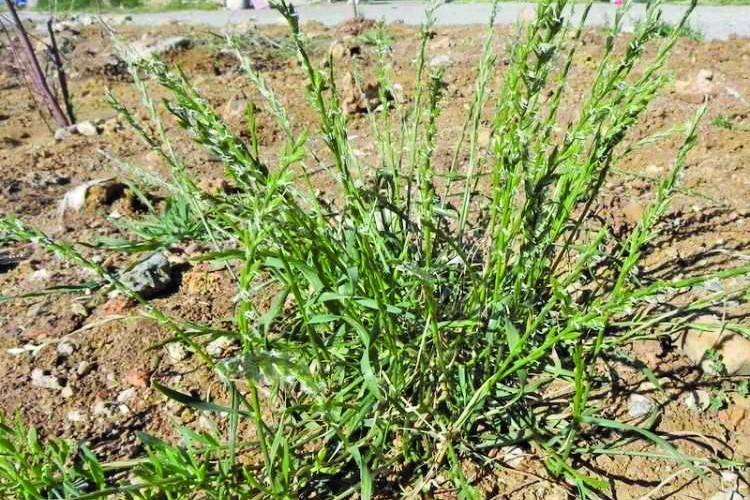General News
24 April, 2022
Ryegrass: one of farming’s greatest foes
ANNUAL ryegrass is an annual weed

ANNUAL ryegrass (Lolium rigidum), also known as Wimmera ryegrass, and a new study from the University of Queensland shows that the fight against this weed is getting tougher.
Annual ryegrass was introduced to Australia in the 1800s as a forage crop, but its resilience, high seed yield, and ability to host diseases that damage other crops and harm livestock, has turned it into a noxious weed for many farmers.
Annual ryegrass can host Rathayibacter toxicus, a bacteria that normally occurs in soil and is carried into the ryegrass seed heads by Anguina funesta nematodes. Seed heads infected by R. toxicus can remain toxic for years if dry, and cause ARGT, an acute, often fatal, neurological disease which affects livestock grazing on pasture, crop stubble, or infected feed.
Annual ryegrass is also susceptible to rust, which inhibits the growth of clover pasture, decreasing its availability to livestock, and ergot, a toxic fungus which can then infect other grain crops growing nearby.
Past studies have shown that under ideal conditions annual ryegrass can produce around 45,000 seeds that are increasingly resistant to glyphosate, Group A-FOP and DIMs, and Group B-sulfonylurea, making it harder and more expensive for farmers to control.
Farmers in Rainbow have struggled with controlling ryegrass in crops.
“I’ve had whole B-double trucks of grain rejected at storage sites because there was too much ryegrass in it,” a local farmer who did not wish to print his name said.
Rainbow chemical store worker, Chloe Robertson, said that ryegrass is definitely a problem for farmers in the area, and that chemical-resistant varieties are on the rise.
“We are finding that the old chemicals won’t touch it anymore,” she said.
“We have to order a wider range of new generation chemicals, and stock alternative groups of chemicals, so that farmers can control ryegrass on their land.”
Wimmera ryegrass has historically been a winter weed, but increased prevalence in summer crops prompted researchers from the University of Queensland to conduct a series of studies to learn more about its germination and growth under different seasonal conditions.
They tested the effects of soil salinity, temperature, light, depth of sowing, and amount of water available to the seeds, and found that although ryegrass grown under winter conditions germinated earlier, were taller, and had heavier seeds, the number of seeds or tillers produced remained the same.
Researchers also studied the germination of annual ryegrass seeds harvested in summer compared to seeds harvested in winter, with results showing that ryegrass seeds can remain dormant until sufficient water is available, and will germinate under a very wide range of conditions. This adaptability makes it difficult for farmers to implement control methods based solely on geographic or seasonal conditions.
In an interview with WeedSmart, Dr Chris Preston, Professor of Weed Management at the University of Adelaide said that ryegrass species can interbreed, making them even more resilient.
“The genetic diversity of the ryegrass species has seen populations adapt very quickly to altered environments,” he said. “The most widely researched adaptations have been those associated with herbicide resistance, but we are also seeing many other examples of ryegrass evading cultural controls, adapting to new farming systems and extending its geographical and climatic range.”
Early detection and intervention can prevent ryegrass from becoming a widespread problem on farms, but controlling the spread and eradicating the seeds is becoming increasingly difficult with growing chemical resistance.
The Wimmera Mallee region has already been a part of a number of studies into weed control, and has proven to have a large number (over 70 percent) of chemical-resistant varieties of ryegrass, and other weeds.
In November, 2001, the Department of Primary Industries and Regional Development, Western Australia released the results of a study into effective control methods of ryegrass.
The most successful methods were inversion ploughing with a skimmer, and double knocking with glyphosate, followed by a Group L herbicide 3-14 days later.
Field control studies conducted by the University of Adelaide over four years, showed that cutting oaten hay for hay reduced the amount of ryegrass schools by 86 percent per m², while a trifluralin-resistant ryegrass in field pea crops was successfully eradicated with clethodim.
Integrated solutions are vital for slowing resistance to chemicals and controlling ryegrass in the long term, as is rotation of the products and herbicides group being used to spray weeds.